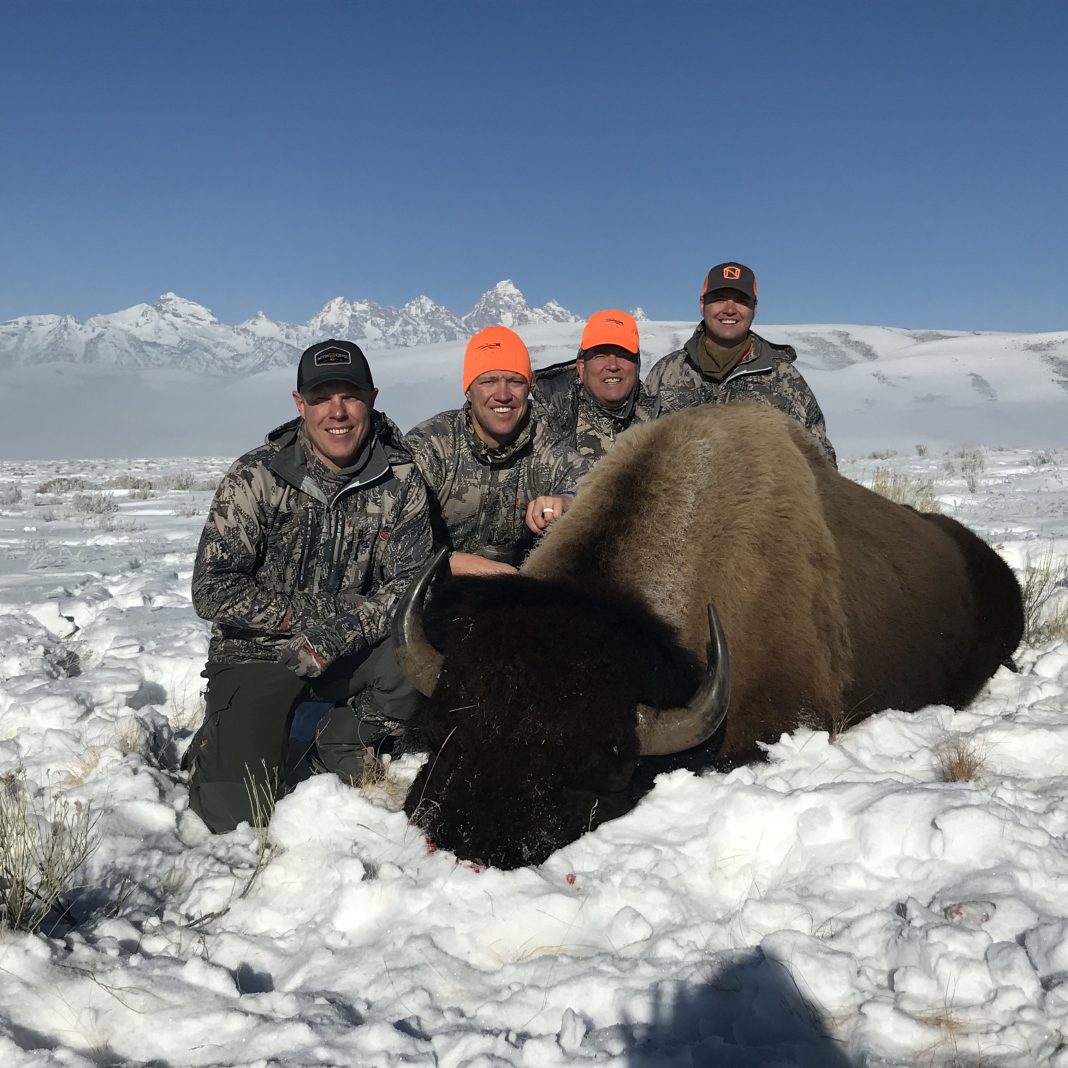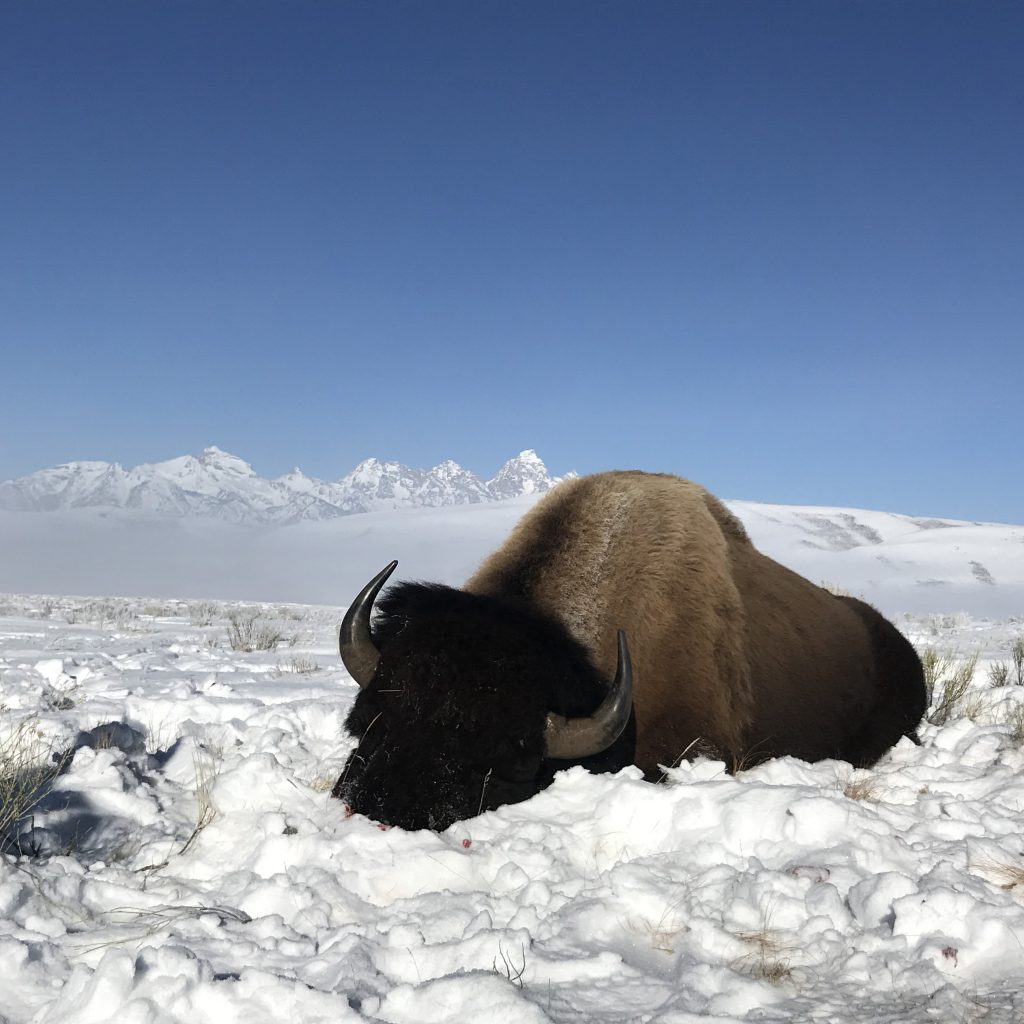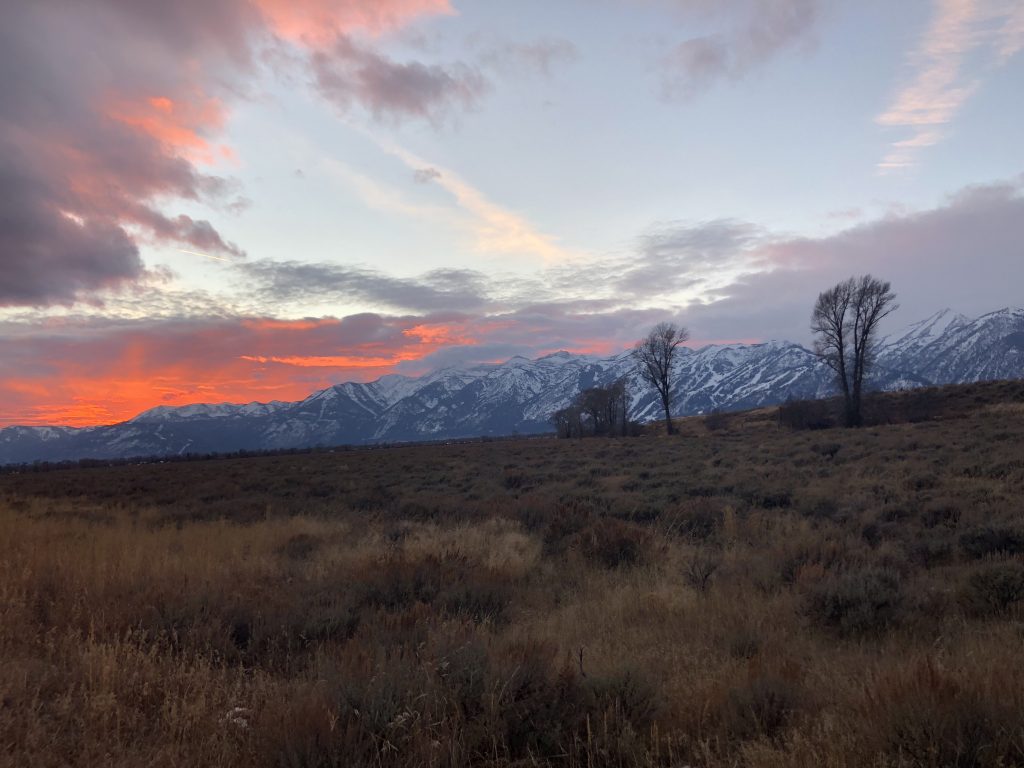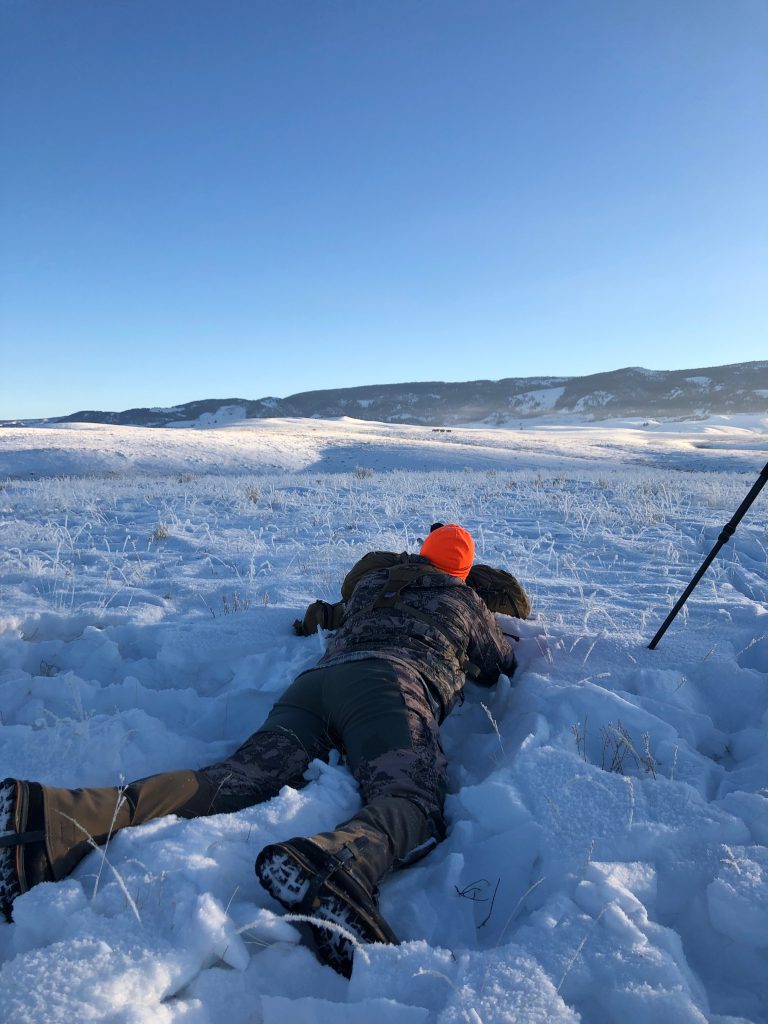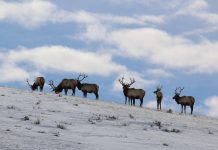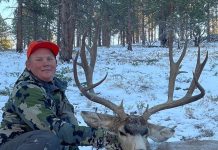I’ve seen about 250 buffalo in the past week, and around 1200 in the past two months. The one that I’m looking at checks all the boxes: mature bull – check; wide head – check; full coat – check. He even has a nice dusting of snow on his back, although he is missing the big afro most of the older bulls have. I don’t know if that’s just his genetics, or maybe he’s not progressing well with his broken left front leg. Most of the time I wouldn’t mind my quarry having a broken leg, but this one is about half a mile from the national forest boundary, and he will not get there on that leg. I certainly cannot shoot one in Grand Teton National Park, unless I want to spend a couple of months in jail. Instead, I call the local game and fish office to make sure they don’t make an exception for broken-legged buffalo. I even tell them I am happy to put it out of its misery, with my tongue firmly planted in my cheek. As expected, they laugh and tell me “No!” It’s too bad, I think as I hang up and continue to watch the old bull. My conversation alerted him to my presence, and he stares at me with a piercing gaze. Despite the broken leg he attempts to paw the snow and raises his tail in the air; telltale signs of aggression. He is still resilient. That is a quality I respect. I grab my pack and start walking away. It really is too bad. He won’t make it through the winter.
I’ve always respected buffalo, or bison (it’s funny how the different names evoke certain emotions in people). It helps that my state flag growing up had a bison on it. It’s fitting that our national mammal is bison. It represents both the best and the worst of American society and American hunters. After all, it was Americans, including in some instances Native Americans that decimated a population of about 40 million to several hundred at the end of the nineteenth century. I don’t know if 40 million buffalo could even exist in our currently populated country (probably not – Google “eruptive dynamics” sometimes), but just thinking about a mass slaughter like that should make any outdoorsman a little sick. However, American’s believe in redemption, and it was conservationists, ranchers, and hunters (namely a hunter by the name of Teddy Roosevelt) who redeemed the buffalo. It now stands as a true testament to what we can accomplish with sound management practices. There are now free-range buffalo hunting opportunities in Alaska, Arizona, Montana, South Dakota, Utah, Wyoming, and Canada.
The first settlers to arrive in my hometown of Star Valley, Wyoming described herds of buffalo throughout the 50-mile valley. I have a picture in my mind of what that would have been like; the proverbial good ole’ days. I like to think I would have been a responsible sportsman; harvesting only what I needed and using the whole animal. Those days have been gone for a long time, but everyone needs dreams. So, when January 2018 rolled around I dutifully filled out my Wyoming bison application with 2,078 others, despite the increased cost of a nonresident tag to $4,402 (a number that still makes my wife cringe). Two months later the draw was complete, and my wallet was empty.
I spent a lot of time that summer in Grand Teton and Yellowstone National Parks, as well as Antelope Island State Park. Did you know that bison have a distinct musky smell? It’s actually quite similar to the smell of a free-ranging horse. I also learn there are a remarkable amount of differences between bulls of varying age classes. Sometimes the older bulls are deceptively large simply because their head is so big. The rut is especially fun. The bulls have a distinct guttural bellow that is purely prehistoric. That combined with the raw power they exhibit when fighting is like stepping back in time. I notice, perhaps for the first time ever, how fast they really are. Speaking of which, did you also know that buffalo stot? Stotting is when ungulates jump and land on all four feet instead of being limited to open running. Most of us have seen mule deer and antelope do it, as well as several African species, but it about knocked me over the first time I saw it from a buffalo. In early October we snuck in on a couple of bulls bedded in a stand of aspens. The wind shifted, they smelled us and promptly left, stotting away as easy as a mule deer. I had no idea something so massive could look that graceful.
I also learn, painfully, that these buffalo are not as docile as I expected. In the past four months since the season started, only 13 buffalo have been taken; the smallest harvest in the past 20 years. They are getting smarter. That is something I can attest to as I watch a herd of 18 bulls on a, particularly cold and exhausting day in late December. I have been chasing them for the past 8 hours back and forth through 4 miles of snow. All I have to show for it is a clump of buffalo hair caught by a tree limb as the herd once again evaded me. I’m tired mentally, physically, and emotionally. I don’t have many days left but I need to get back tonight for church and family. For the very first time, I think that I may not fill this tag, and that is a painful thought. It’s almost as if my experience with them mirrors their own history: down but not out.
Patience is a virtue and while I yearn to be chasing buffalo, the decision to come home to my family is a good one. I’ve been away from them a lot this hunting season, not just after buffalo but elk and deer too. It has been a good, relaxing day. At around 6 p.m. just as we are cleaning up dinner, I suddenly get a call from a fellow buffalo hunter, Andy. “You won’t believe this, but I have six bulls half a mile away, and they are on the right side of the boundary.” I would have preferred that news the day before, but am excited for Andy who has put in just as much effort. He calls me back 30 minutes later with some excellent news; he has a really nice bull down and the other five have not left the area. I debate for a good 20 minutes whether I should drive the 280 miles I just drove back to Wyoming. It’s not much of a debate and I have been blessed with an incredible wife. Thirty minutes later my best buddy, Shawn, and I are on the road.
It’s 15 below zero the next morning. Interestingly, in the 1970s a group of researchers put a buffalo, a Tibetan Yak, a Scottish Highland cow, and a Hereford cow into insulated boxes and started lowering temperatures to assess cold tolerance. The Hereford hit its cold tolerance at 14 degrees, the Tibetan and Scottish at -13. The boxes hit their limit at -22, the buffalo still unfazed. In that sense, the buffalo have beaten me again, because I am cold. I am hiking with Shawn, my dad, and my brother, Brad towards the area where Andy last saw the buffalo the night before. Another friend, Art, who also has a buffalo tag, is checking another area northeast of us. It’s that time of morning when it’s just starting to get light and you can actually see more than a couple of feet ahead. The air is crisp and clean. North of us is a series of plateaus with several small cuts running westward, and if the buffalo went far enough the Gros Ventre River, which separates us from Grand Teton National Park. East is a portion of the Gros Ventre mountain range, west is the Grand Tetons, and south is Jackson Hole, Wyoming. Most of that is covered in a thick layer of fog. As we hike we scan the hills and meadows ahead. We haven’t gone too far when we see several dark shapes on a ridge one mile away. Within seconds binoculars are pressed to all of our eyes. Buffalo. Nine of them. The problem: there are about 500 wintering elk between them and us. There is no way to get to the buffalo without spooking the elk. So, we decide that a direct route is best, hoping that we can quickly get within range while not scaring the buffalo too much. It works, kinda. The elk predictably start scattering but the buffalo stay until we are 800 yards away. They decide that is close enough and start heading North over the ridge. We take advantage of their momentary disappearance by hoofing it up the ridge. As we crest the ridge and peak at the plateaus beyond, the air is calm and there is that stillness just before the sun arrives and everything comes to life. There is an anticipation I can’t quite describe.
We have closed the distance to 530 yards. My experience tells me we may not be able to get any closer, and the terrain is so wide open that they would see us in any direction. I have practiced for this scenario many times – range, dope, wind, execute. With my turret dialed I settle my crosshairs on the chosen bull while also settling my emotions. I can get excited later. The ethical hunter hopes for the fastest and most humane kill possible. My respect for these animals dictates that I properly execute the shot. As I exhale and just reach the bottom of my breath, I slowly pull the trigger.
If you have ever shot a rifle in really cold temperatures, the moment after you shoot has an odd silence to it, almost as if you have a suppressor on the barrel. I can see the old bull arch his back sharply and drop back down as my bullet reaches him; the telltale sign of a lung hit. It is over within a minute. Whenever I harvest an animal, I feel a whirlwind of emotion. Elation at success. Exhaustion accumulated over months of effort. Humility when considering the responsibility I have for conservation. Respect for such an incredible animal. Those emotions hit me now as we walk up to the buffalo, and I can’t help but feel gratitude for such an incredible opportunity with family and friends. Suddenly, the sun arrives and burns off the fog revealing the Grand Tetons in the background with the snow shimmering all around us. Art has another buffalo down just 50 yards away. Today is going to be a good day.
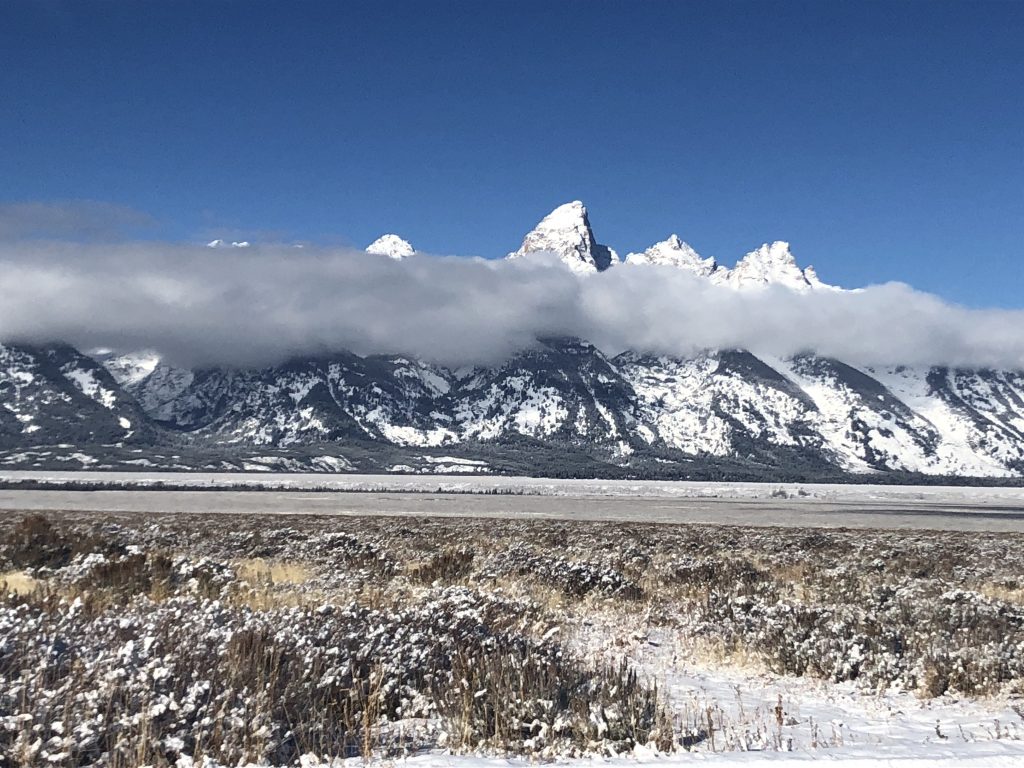
By the end of the season, only 34% of licensed hunters have tagged out; a historically low number. It actually prompts the Wyoming Game and Fish Department to send a letter to potential buffalo hunters in 2019 informing them of the low chances of success. My success is not lost on me. I have already shared close to 100 pounds of steaks, roasts, hamburger, and jerky of the 800 from my buffalo with family, friends, neighbors, co-workers, acquaintances, and in at least one instance an anti-hunter. Gladly I do so, knowing that as I share my fortunes we all collectively share a piece of history and the lessons learned from that history. I know I will take my family to Yellowstone yearly to see the buffalo and remember their history, and hopefully to improve it. My kids will probably get sick of me telling them each time we go up to where dad got his buffalo, but I hope they will realize the price I paid, and the price hunters have always paid, to conserve the natural resources Americans have been so abundantly blessed with. After all, nature is something we all have in common. As a wise man once said, “One touch of nature makes the whole world kin.” William Shakespeare


